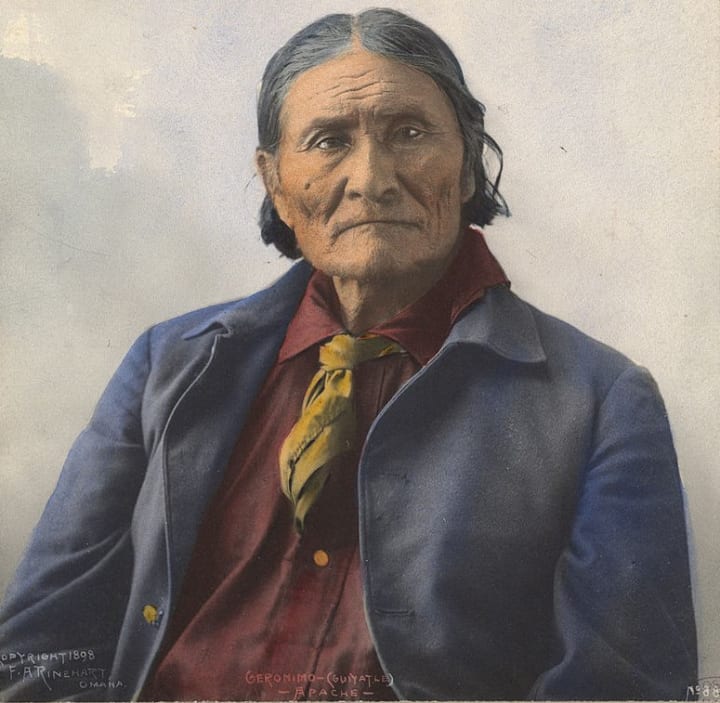Congratulations to the Winners
Flat Vocals


The struggles of African Americans and women, as important as they are, have often overshadowed the struggles of Native Americans, an increasingly marginalized minority. Between 1950 and 1970, the American Indian rights movement experienced some major civic victories, but by the 1970s, Native Americans were still living in the "gray areas of society" and facing enormous social difficulties. By tracing the course of the Native American rights movement, its success or failure should become apparent, but this is one social movement that may not be so easily judged.
Much of the modern problems Native Americans face are the result of treaties struck in the late nineteenth century, so to better understand the modern plight of Native Americans, it is important to briefly explore the origins of the alien/aboriginal relations.
Essentially, the conflict between whites and Native Americans began when Christopher Columbus first landed in the Caribbean. It was these early explorers, in their quest for gold and other natural resources, who cleared the path for eventual colonization.
European colonization had devastating effects on the aboriginal peoples of the Americas. The once thriving population went into cataclysmic decline. Today, there are little over two million Native Americans living in the United States. This depopulation was due to both passive and aggressive forces: disease, forced relocation, and genocide. The unfairness of the treaties became apparent when white Americans began to force Native Americans onto smaller and smaller tracts of land, called reservations. The Native Americans, both technologically weak and culturally disjointed, were ultimately defeated.
The twentieth-century conflict between the United States and Native American Indians is vastly different from the conflicts of the nineteenth century, but the old grievances still stand. Based on the law, both in the era of westward expansion and today, many of the treaties between the U.S. government and Native Americans were illegal.
World War II helped create a spark for change within the Native American community. Over twenty thousand Native Americans had served in the military during the war, and others went to work in "war industries around the country." Native Americans became urbanized, and those who returned to the reservations after the war helped plant the seeds of social activism. Native American demands were quite clear: return illegally procured lands or pay reasonable reparations for those lands.
The period from 1945 to 1968 is often referred to as the Termination Period. Tribes that were once self-governed lost their status under a statute enacted in 1953 called Public Law 280, which maintains that states have jurisdiction over Indian Affairs. Under Public Law 280, Native Americans lost the right to self-determination. Tribal representatives spoke to officials about the unfairness of the law but were either shut out or shut down.
This law was due in large part to the policies of the Truman and Eisenhower administrations, both of which supported legislation that was unfavorable to Native Americans. Public Law 208 was one of the laws included in House Concurrent Resolution 108, which sought to end all federal involvement in Indian affairs. Poverty was already a problem on the reservations, and House Concurrent Resolution 108 and the lesser Public Law 208 threatened to make the poverty situation infinitely worse. The Termination Period was a time of great uncertainty for Native Americans, but it was also a time of significant change. Native Americans were no longer content to sit passively by and let the U.S. government, which had already taken so much, take what little remained.
During this period, there also began another period in Native American history, and this period was in direct response to the era of termination. The Self-Determination Period was a time of increased social activism among Native Americans. They too embraced the zeitgeist of the 1960s by engaging in protest marches and collectively
bringing their plight to the forefront of American society. Perhaps the most audacious Native American rights group was the American Indian Movement (AIM).

In response to police brutality on American Indian people, the American Indian Movement began the AIM Patrol. AIM received the most attention among Native American protest groups because they usually engaged in radical protests, sparking prompt media attention. Their actions were even more audacious than the land seizure protests which began in 1968. Tribes would block access to so-called publicly owned land to make their message sufficiently clear. The demands presented in the post-WWII era were still the same: land or reparations.
Also in 1968, Native Americans experienced perhaps their greatest victory. In response to the pressure being applied by Native activists, the United States government passed the Indian Civil Rights Act in 1968, which granted tribal governments and the Native Americans they served more rights under the Constitution, meaning full protection under the Bill of Rights. Freedom of speech and freedom of religion were granted, reversing the attempts by the government to assimilate the natives completely and subsequently destroying their religious beliefs and cultural identity.
In addition to these new protections, amendments were made to Public Law 280, in the hopes of bolstering and restoring the practice of self-determination. But the battle for equal rights was far from over. The radical organization AIM and its sister organizations still had other grievances.
The reason AIM used such radical tactics was that leaders of the movement wanted to convey their message without the usual political spin from Washington, and the best way to do that was to be shocking and provocative. In 1968, the same year the Indian Civil Rights Act became law, Native American protestors took partial control of Alcatraz Island. The Alcatraz siege lasted until 1971.
In the wake of Alcatraz, the movement borrowed a page from the African American Civil Rights playbook. The Trail of Broken Treaties protest caravan came to Washington, D.C., in grand fashion to present government officials with a list of grievances. They demanded, among other things, the complete repeal of Public Law 280 and the restoration of all terminated rights. They also called for the abolishment of the Bureau of Indian Affairs.
Apparently, the government did not react quickly enough because the following year, armed AIM activists seized the town of Wounded Knee in South Dakota. This siege was meant to bring attention to the plight and suffering of Native Americans.
These protests were not unsuccessful. When Richard Nixon ascended to the presidency, he made Indian affairs a top priority. The president seemed genuinely sympathetic to their plight. This may or may not have been a genuine plea for more protections for Native Americans, but it was in the 1970s that the most favorable Native American legislation took place: the Education Assistance Act of 1975, the Indian Child Welfare Act of 1978, and the Indian Religious Freedoms Act of 1978, among a few.
The Indian Religious Freedoms Act was a particularly resounding victory. Not only had the government actively attempted to rid Native Americans of their religious beliefs, but they also banned them from using traditional ceremonial substances, such as peyote. At the end of the decade, the future of Native Americans seemed bright, or at the very least, less gray, but epidemic poverty still held Native Americans hostage.
An answer to this problem came in 1978 when the restored tribal government made their first foray into gambling to raise money for their respective councils. Starting with Bingo parlors and then graduating to casinos, Native Americans had found their niche industry. In addition to the emerging gaming industry, Native Americans also began to have some success with reparations. Was that enough, though, to make up for all the sins of the past?
Many tribes did not benefit from the legislation produced in the 1970s, and some have opted not to pursue a future in the gaming industry, choosing instead to lead more traditional lives in observance of the old rituals. Poverty is still apparent on most Indian reservations, and the Native American struggle continues, particularly over water rights in the American Southwest. Still, among those who did not benefit from legislation or gaming, there are a number of success stories.

Sherman Alexie, a Native American author, is one such success story. Alexie does not see the Native American movement as a failure, despite the abject poverty many Native Americans still face. Instead, he takes a more pragmatic approach. "We're not getting it back," he says of the lands taken from his people, citing a complex issue with land returns. He expounds even further on this point when he says, "[Land], language, culture, who we were when the Europeans first arrived" cannot be given back.
In the United States today, there are "562 recognized Indian tribes". These tribes, or nations as they are often called, retain some level of sovereignty, but the opportunities available on Indian reservations are quite limited. There are colleges on the reservations, but the Native American youth has become disenchanted, particularly about their future.
Since its very beginnings, the United States has abused and exploited Native Americans. They were once members of great nations, and although they were disjointed and often in conflict with one another, they were not all savage warriors prone to mutilation and rape. Some tribes, like the Iroquois and the Sac, had functioning governments on par with the principalities of Europe.
The perception of them being fierce and animal-like was exploited and propagandized to give credence to injustices and atrocities perpetrated by the American government. According to Dennis Bank, the leader of the American Indian Movement, it was these images that made it easier for the government to ignore the tribes of the Americas. Eventually, the image would fade, but the natives still had a hard road to travel, a road they are still traveling to this day.
The mid-point of the twentieth century was a turning point for quite a few American civil rights movements, many of which enjoyed tremendous success. The Native American Indian movement may have had a number of successes, but poverty and addiction have crippled large numbers of the remaining population. The battle for the liberties enjoyed by other Americans still rages. It is for this reason that judging the success or failure of the Native American Indian movement is so difficult.
About the Creator
Mack Devlin
Writer, educator, and follower of Christ. Passionate about social justice. Living with a disability has taught me that knowledge is strength.
We are curators of emotions, explorers of the human psyche, and custodians of the narrative.






Comments (1)
But how do you really feel? ;) Seriously, I know how it feels to see all those winners after all that effort and baring of the soul. I have over two hundred pieces up and no wins, even after having a Top Story for one contest and being rewarded for giving them an idea for a contest. Some have over a thousand up and still have no laurels. The life of a writer can truly suck sometimes. But it does not mean to have to let it choke your talent. Keep at it...